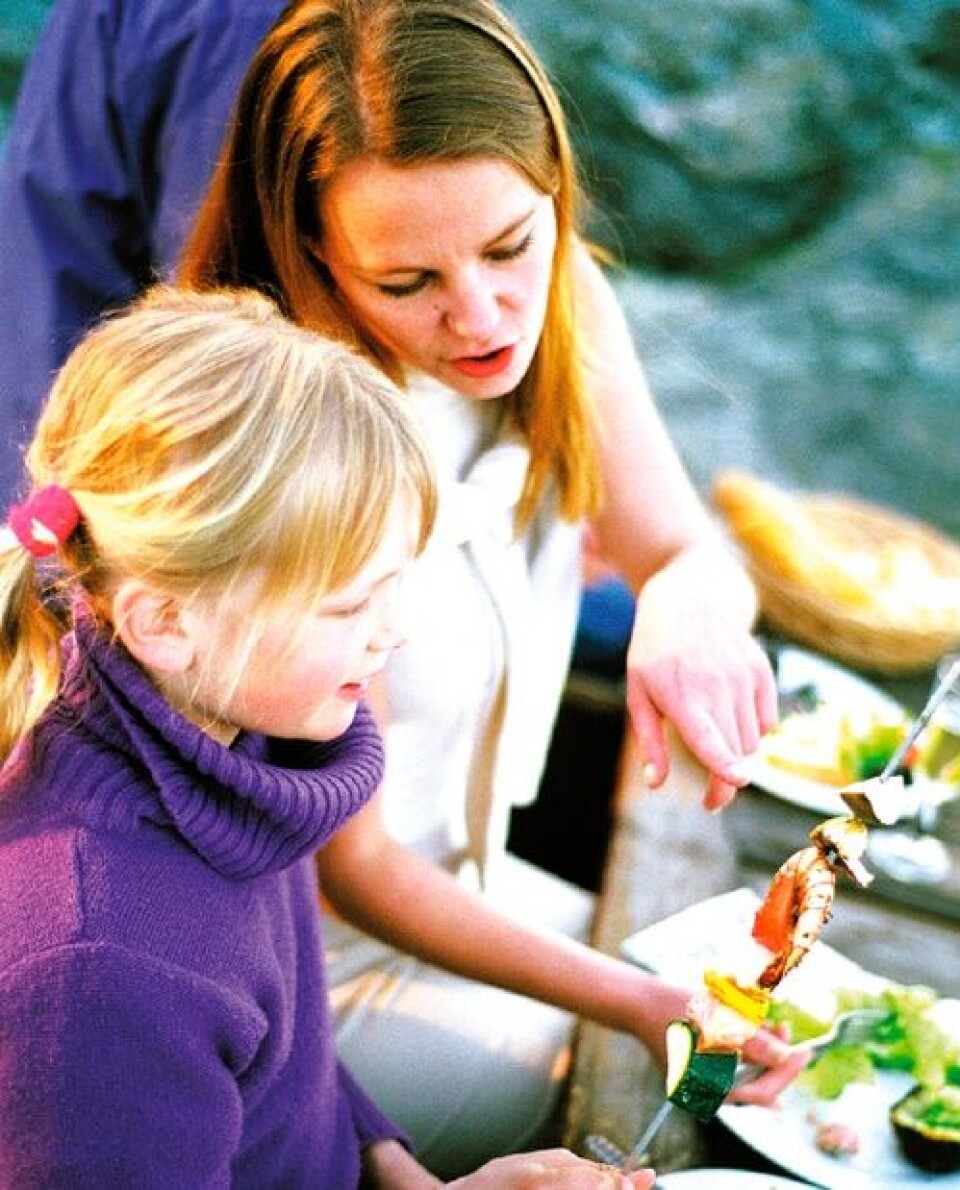How much wild fish is there in fish farming feed?
Fishmeal and fish oil have an optimal nutritional composition for farmed fish, and they were previously both affordable and readily available ingredients. Today, fishmeal and fish oil produced from wild fish are limited resources, and global growth in seafood production requires less use of wild fish as a raw material in fish feed. Examples of alternative raw materials are plant protein ingredients and vegetable oils. When one wants to minimize the proportion of wild fish used in fish feed, it is essential that the salmon’s health, welfare and product quality are ensured in the best possible way. When we, through feeding trials, reduce fishmeal and fish oil by as much as 70–80%, the salmon’s metabolism, fat storage pattern and antioxidant status are affected. Also the amount of marine omega-3 fatty acids in the fillet is lowered when one feeds the fish with reduced amounts of fish oil. This is not the case for proteins because the protein composition of the salmon does not change, even if the source of protein comes from plant products. Fish farming implies a trade-off between how much wild fish to use in salmon feed and the amount of omega-3 fatty acids and other important nutrients one wants in the salmon fillets.
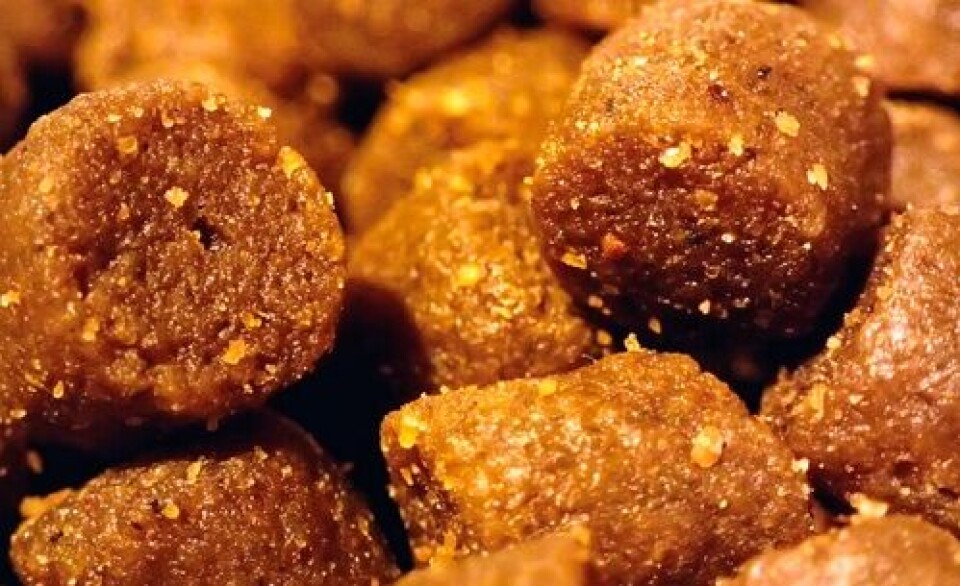
Fish In Fish Out - FIFO By reducing the proportion of fishmeal and fish oil in fish feed, the amount of wild fish required to produce one kilogram of farmed fish will go down. One way to calculate this decrease is by calculating the ratio: Fish In Fish Out (FIFO). The term FIFO expresses how many kilos of wild fish to use to produce one kilogram of farmed fish, in this case farmed salmon. In calculation of FIFO, the following factors play an important role: 1) Number of kilograms of fishmeal and fish oil one gets from the wild fish 2) Number of kilograms of feed the farmed salmon eats to increase weight by 1 kg (feed factor) 3) Amount of fishmeal and fish oil used to make fish feed What is important in calculating FIFO? There is much disagreement about how FIFO should be correctly calculated. This is related to how effectively we can produce fishmeal and fish oil from different species, as well as to which feed factor is most correct to use in the calculations, since feed factor is variable. Official statistics from the Directorate of Fisheries (2008) show that the average feed factor for salmon and trout in Norwegian companies is 1.25. The amount of fish oil one gets from 1 kg of fish varies from 5% from the lean wild fish species to about 12% for the oilier species, this proportion is the most critical factor for the outcome of the FIFO calculation. Therefore, it will obviously be crucial for FIFO which species the fish oil used in fish farming feed is made from.
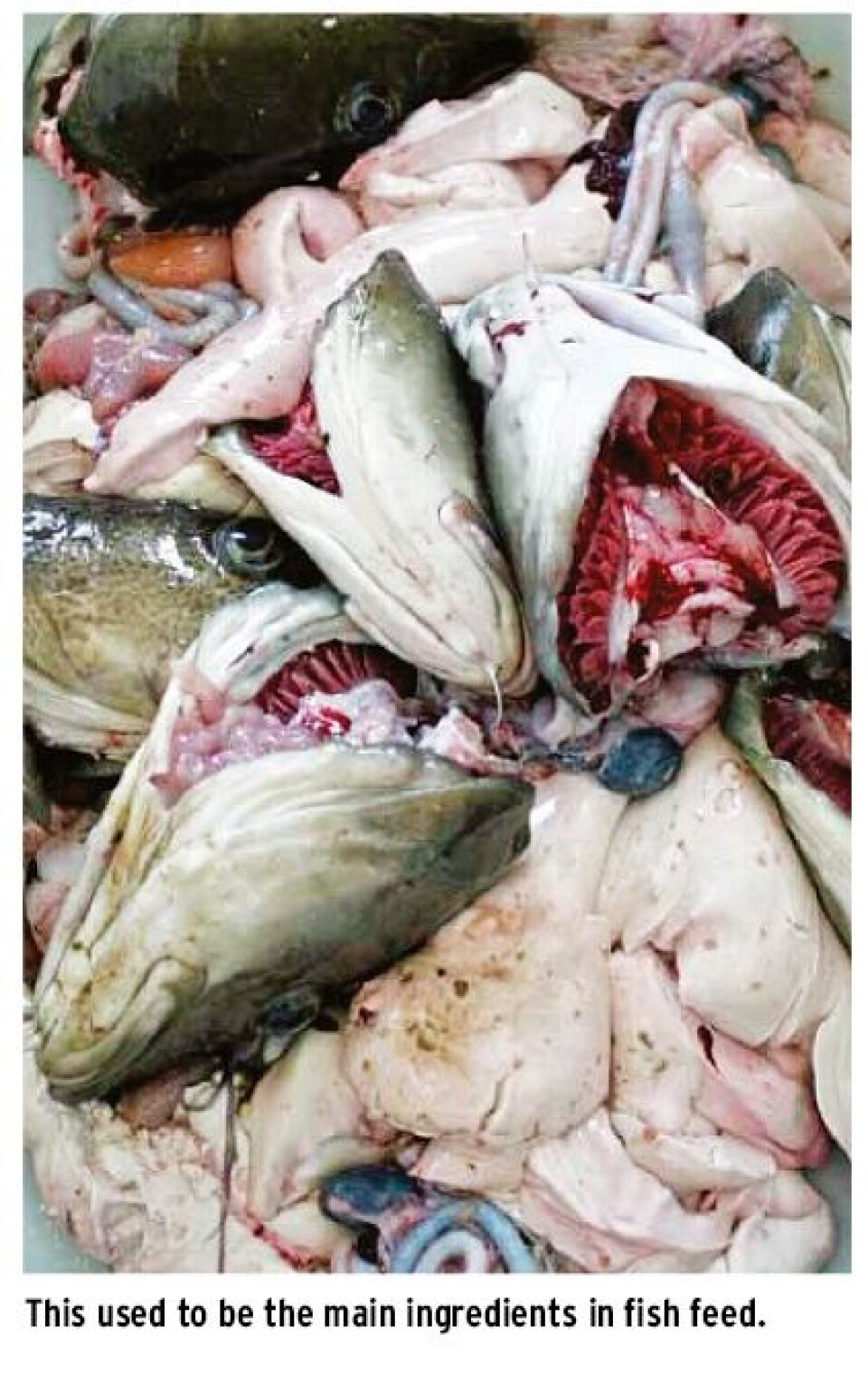
Some examples of FIFO from feeding trials at NIFES To illustrate how much wild fish is used to produce salmon when feed ingredients vary, following below are some examples of calculations of FIFO from three different feeding trials with large salmon conducted at NIFES (Table 1). The figures on which the FIFO calculations in Table 1 are based, are from three research projects, and include fishmeal and fish oil-based feeds where parts of the fishmeal and/or fish oil are replaced with plant ingredients. In commercial feeds to farmed salmon, both fishmeal and fish oil are replaced with a share of other feed ingredients such as plant proteins and vegetable oils. The calculations (Table 1) made for feed 2, which contains only fishmeal and fish oil, show that FIFO will vary from 2.1 to 5, depending on the percentage of fat in the fish species from which the oil is produced. In the other four feeds, fish oil and/or fishmeal are replacement by plant ingredients, and FIFO varies also here. Both the species from which the fish oil is made, and the amount of fishmeal and oil used in the manufacture of feed, will thus affect FIFO. The calculations of FIFO in Table 1 are made on the basis of feeding trials in research, and may be different from FIFO for commercial feeds. Some commercial feed manufacturers calculate and report FIFO for their food, and the information is often available on the manufacturers’ websites. Skretting states that 2.02 kg of fish is used to produce 1 kg of salmon( in norwegian only). Environmental organisations are also interested in alternative feed ingredients, and WWF has done its own calculation of FIFO on its Norwegian website. They state in their calculation that 3.024 kg wild fish is used to produce 1 kg of farmed fish.
Calculation of FIFO, an example The following key figures are used in the calculation: In the production of fishmeal, 1,000 kg of raw fish material gives 228 kg of fishmeal (2007 International Fishmeal and Fish Oil Organisation – IFFO). The amount of fish oil one gets from wild fish is dependent on the species used in production. Capelin contains approximately 5% fat in whole fish, and it can thus be expected that 4.39 kg of fish gives 1 kg fishmeal and 20 kg of fish gives 1 kg fish oil. By comparison, the FIFO would have been half compared to using fish oil based on a species of about 10% fat where 10 kg of fish gives 1 kg fish oil. The oiliest wild fish species used for fishmeal and fish oil contain approximately 12% fat while the leanest fish used in fish oil production contain approximately 5% fat (2010, International Fishmeal and Fish Oil Organisation – IFFO).

Thus, the calculation of FIFO in feed 5 is:
Amount of fish oil: 1 kg of salmon x 1.2 feed per kg of salmon (feed factor) = 1.2 kg of feed 1.2 kg of feed x 0.062 kg of fish oil per kg of feed = 0.07 kg of fish oil 0.07 kg of fish oil x 20 kg of fish per kg of fish oil = 1.5 kg of fish Amount of fishmeal: 1 kg of salmon x 1.2 feed per kg of salmon (feed factor) = 1.2 kg of feed 1.2 kg of feed x 0.180 kg of fishmeal per kg of feed = 0.216 kg of fishmeal 0.216 kg of fishmeal x 4.39 kg of fish per kg of fishmeal = 0.95 kg of fish To produce 1 kg of salmon based on a feed containing 6.2% fish oil (feed 5) we need 1.5 kg of wild fish, and to produce 1 kg of salmon based on a feed containing 18% fishmeal we need 0.95 kg of wild fish. The calculation example above shows that it is the fish oil which is deciding of the amount of wild fish used to produce 1 kg of farmed fish. It would be wrong to add 0.95 kg and 1.5 kg together for calculating the amount of wild fish used in this example. Both raw materials come from the same fish lot, and are used to produce both the fish meal and the fish oil. In our calculation example, this means that to produce 1 kg of farmed salmon we need 1.5 kg of wild fish, thus FIFO = 1.5 for feed 5.
How to reduce the amount of raw fish material from wild fish in feed? It is generally the proportion of fish oil that is crucial for the amount of wild fish required to produce fish feed. When the proportion of fish oil decreases, the FIFO correspondingly goes down. In feed 3 in Table 1, the amount of fishmeal was reduced more than the fish oil, but this was not reflected in FIFO since the production of fish oil that was used required more wild fish than the production of fishmeal. To achieve a FIFO under 1, i.e., less than 1 kg of wild fish to produce 1 kg of farmed salmon, one must replace both fishmeal and fish oil, as done in feeds 3 and 5 in Table 1.
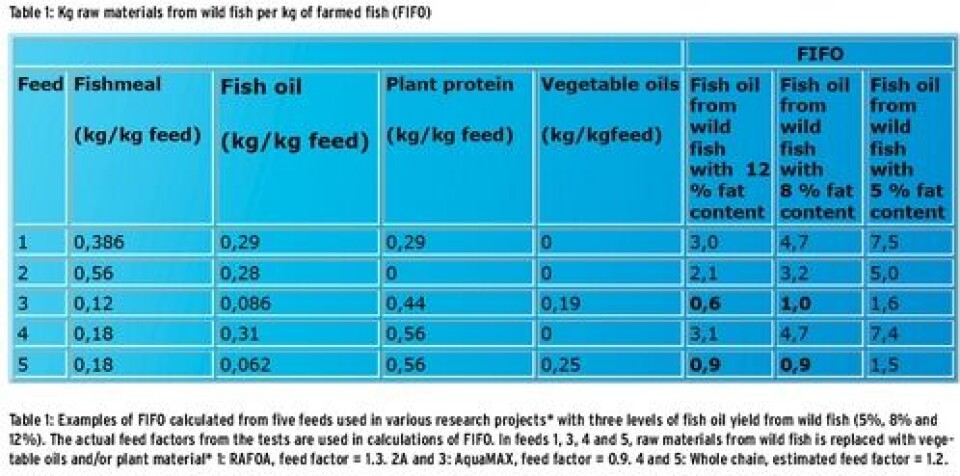
Which fish species are used to make fishmeal and fish oil? Ingredients for fish feed come from the global market. There is great variation in species used in the production of fishmeal and fish oil, but one common trait is that fishmeal and fish oil is produced from fast-growing, pelagic species with relatively short life spans. The fish are small and relatively oily, and the whole fish is used to produce fishmeal and fish oil. Examples of such species are anchovy, horse mackerel, capelin, blue whiting, sand eel, sprat, herring and sardines (International Fishmeal and Fish Oil Organisation – IFFO, www.iffo.net).
Six species are used for production of fishmeal and fish oil in Europe, and these can be divided into three categories: a) Fish that are not used for human consumption (sand eel). b) Fish that can potentially be used for human consumption, but is mainly used for fishmeal and fish oil because of limited outlets for human consumption (blue whiting, sprat and capelin). c) Fish used primarily for human consumption, but where all surplus catch within the Total Allowable Catch, or which does not meet the specifications for human consumption can be used for fishmeal and fish oil (herring). In Peru, anchovy is the most important species in fishmeal and fish oil production. In Chile, horse mackerel, anchovy and sardines are used (International Fishmeal and Fish Oil Organisation – IFFO, www.iffo.net). Excess raw materials as ingredients in fish farming feed? Excess raw materials from Norwegian fisheries and fish farming consists of intestines (liver, roe, milt, bowels, guts, etc.), heads, trimmings, shells, unused fish, and more (www.rubin.no). In addition to whole wild fish, excess raw material is also used in the production of fishmeal and fish oil (International Fishmeal and Fish Oil Organisation – IFFO, www.iffo.net). One example is herring trimmings from the production of herring fillets for human consumption, which in Norway amounted to almost 300,000 tonnes in 2009 (www.rubin.no). In cases where one uses fishmeal, fish oil and fish ensilage based on trimmings, the share of raw materials from wild fish will go down, thereby reducing FIFO.
Does high FIFO mean less seafood for human consumption? FIFO cannot be directly related to the amount of wild fish that could be passed for human consumption, because it does not take into account whether the raw fish material comes from 1) fish that are eaten whole, such as sardines, 2) fish where half of the raw material (fillet) goes to human consumption, such as herring or 3) fish that are mainly not eaten by humans, such as sand eel. For feeds with a FIFO of 2, it would mean that in case 1), 2 kg of wild fish that could have been eaten by humans is used to produce 1 kg of salmon. In case 2), 1 kg of wild fish would be used, and in case 3) 0 kg of wild fish that could be used for human consumption would be used. Fishmeal and fish oil are also used as ingredients in animal feed in agriculture, and in food supplementation (capsules) for humans. EPA and DHA enriched eggs, milk and meat are produced by adding fish oil in the feed.
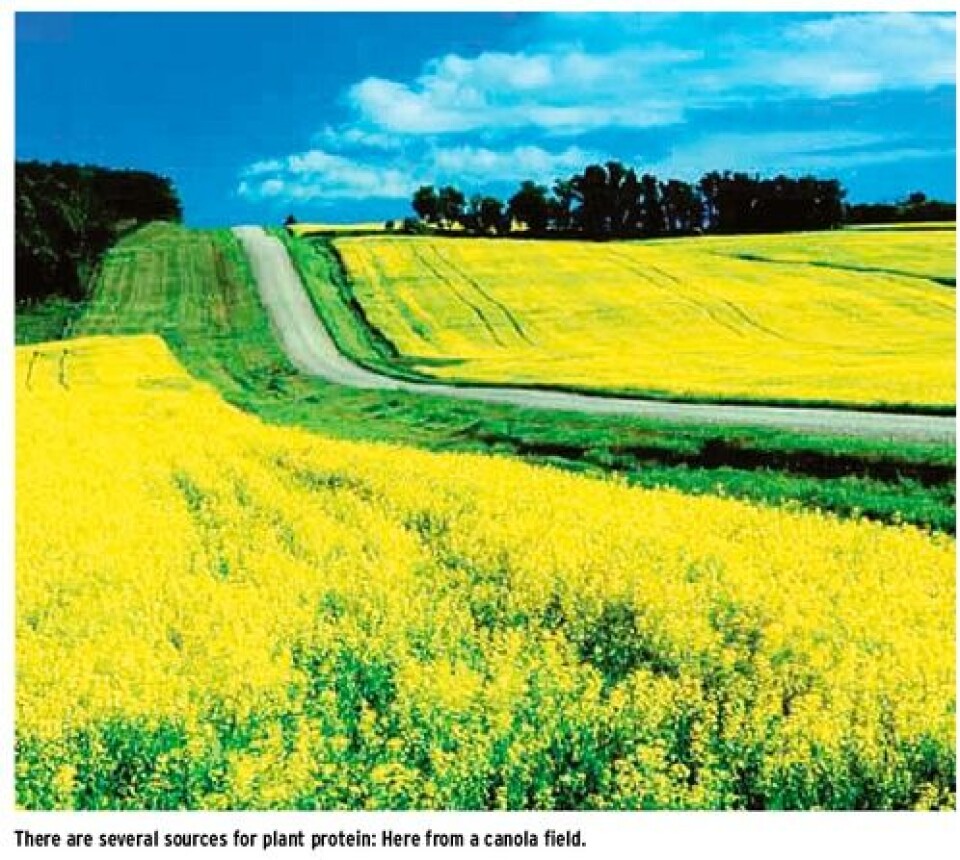
What does FIFO mean for salmon as a source of EPA and DHA? In order to cover EFSA’s recommended daily intake of 250 milligrams EPA and DHA, one has to eat 28 g per day of salmon that is produced with a low FIFO (0.5 to 1.3) (Table 1), or one meal per week (200g). Farmed salmon is thus a very good source of EPA and DHA, even when much of the fish oil has been replaced with vegetable oils and the dependence on wild fish as a feed ingredient is greatly reduced. Reduced FIFO will affect the amount of nutrients, but also the amount of undesirables (pollutants) in farmed fish.
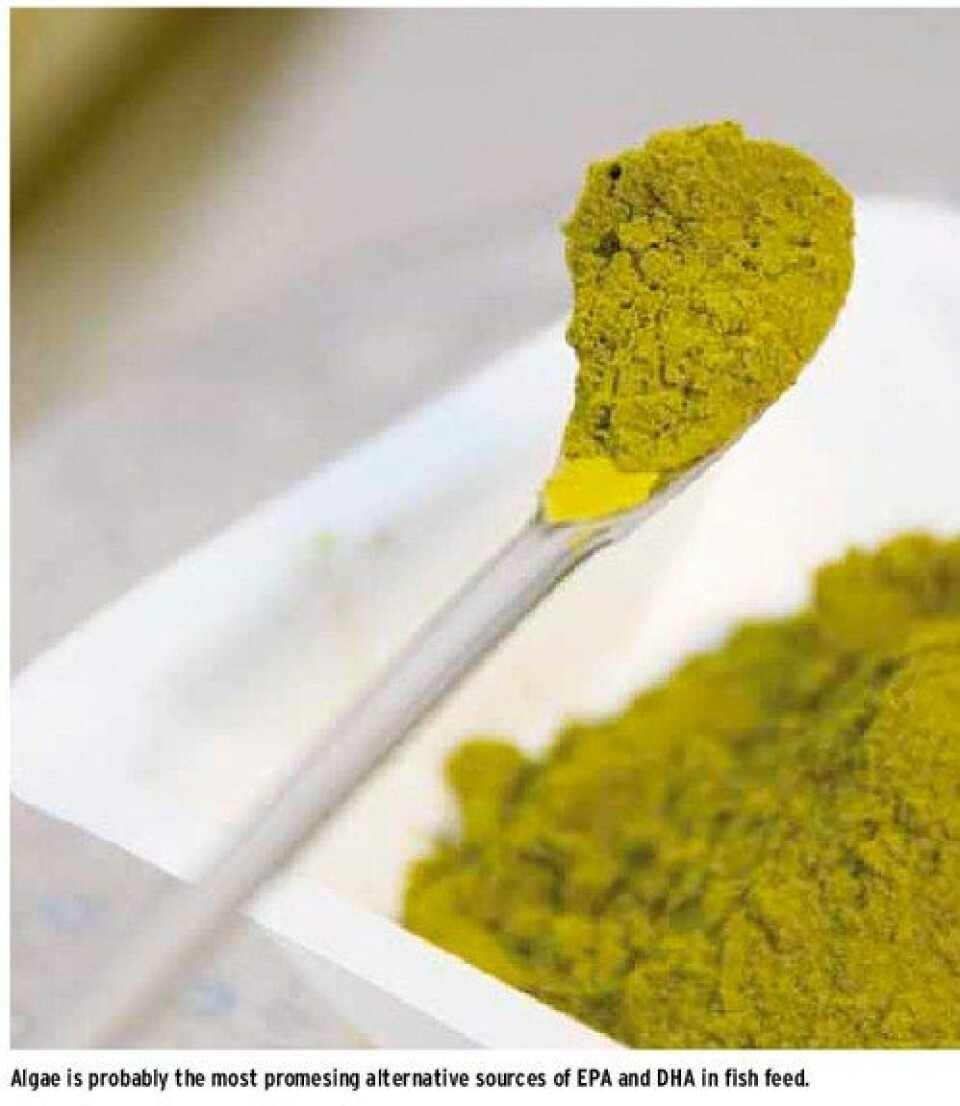
Sources: RAFOA (Researching Alternatives to Fish oil in Aquaculture) EU-prosjekt (Q5RS-2000-30058), http://www.rafoa.stir.ac.uk/ AQUAMAX, IP-EU prosjekt (016249-2), http://www.aquamaxip.eu/ “SAFE FEED, SAFE AND HEALTHY SEAFOOD Contaminants, nutrients and health challenges in the novel production of farmed Atlantic salmon (Helkjede)” Norges Forskningsråd (199626). International Fishmeal and Fish Oil Organisation – IFFO, www.iffo.net Andrew Jackson (2010) Fish In – Fish Out (FIFO) Ratios explained, Fish meal and fish oil association, www.iffo.net. EFSA Panel on Dietetic Products, Nutrition, and Allergies (2010) Scientific opinion on dietary reference values for fats, including saturated fatty acids, polyunsaturated fatty acids, monounsaturated fatty acids, trans fatty acids, and cholesterol. EFSA Journal, 8 (3): 1461, 1-105. Torstensen, B.E., Bell, J.G., Rosenlund, G., Henderson, R.J., Graff, I.E., Tocher, D.R., Lie, Ø. and Sargent, J.R. (2005) Tailoring of Atlantic salmon (Salmo salar L.) flesh lipid composition and sensory quality by replacing fish oil with a vegetable oil blend. J. Agric. Food Chem., 53, 10166-10178. Torstensen, B.E., Espe, M., Sanden, M., Stubhaug, I., Waagbø, R., Hemre, G.-I., Fontanillas, R., Nordgarden, U., Hevrøy, E.M., Olsvik, P.A. and Berntssen, M.H.G. (2008) Novel production of Atlantic salmon (Salmo salar) protein based on combined replacement of fish meal and fish oil with plant meal and vegetable oil blends. Aquaculture, 285, 193-200.
